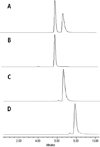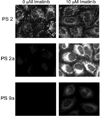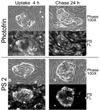Effect of chirality on cellular uptake, imaging and photodynamic therapy of photosensitizers derived from chlorophyll-a
- PMID: 25936263
- PMCID: PMC4461543
- DOI: 10.1016/j.bmc.2015.04.006
Effect of chirality on cellular uptake, imaging and photodynamic therapy of photosensitizers derived from chlorophyll-a
Abstract
We have previously shown that the (124)I-analog of methyl 3-(1'-m-iodobenzyloxy) ethyl-3-devinyl-pyropheophorbide-a derived as racemic mixture from chlorophyll-a can be used for PET (positron emission tomography)-imaging in animal tumor models. On the other hand, as a non-radioactive analog, it showed excellent fluorescence and photodynamic therapy (PDT) efficacy. Thus, a single agent in a mixture of radioactive ((124)I-) and non-radioactive ((127)I) material can be used for both dual-imaging and PDT of cancer. Before advancing to Phase I human clinical trials, we evaluated the activity of the individual isomers as well as the impact of a chiral center at position-3(1) in directing in vitro/in vivo cellular uptake, intracellular localization, epithelial tumor cell-specific retention, fluorescence/PET imaging, and photosensitizing ability. The results indicate that both isomers (racemates), either as methyl ester or carboxylic acid, were equally effective. However, the methyl ester analogs, due to subcellular deposition into vesicular structures, were preferentially retained. All derivatives containing carboxylic acid at the position-17(2) were noted to be substrate for the ABCG2 (a member of the ATP binding cassette transporters) protein explaining their low retention in lung tumor cells expressing this transporter. The compounds in which the chirality at position-3 has been substituted by a non-chiral functionality showed reduced cellular uptake, retention and lower PDT efficacy in mice bearing murine Colon26 tumors.
Keywords: Cell-specificity; Chlorophyll-a; Imaging; Photodynamic therapy; Photosensitizer.
Copyright © 2015 Elsevier Ltd. All rights reserved.
Figures











 ) and 128J/cm2, 14 mW/cm2, (
) and 128J/cm2, 14 mW/cm2, ( )]. (B): PS 2 and the corresponding R- and S- isomers 3, 4; (C): isomers 5 and 6 and, (D): PS 2 and PS. 9 (achiral at position-3). All animals in B to D were treated with 665 nm light (128J/cm2, 14 mW/cm2), Tumor growth was monitored daily for 60 days.
)]. (B): PS 2 and the corresponding R- and S- isomers 3, 4; (C): isomers 5 and 6 and, (D): PS 2 and PS. 9 (achiral at position-3). All animals in B to D were treated with 665 nm light (128J/cm2, 14 mW/cm2), Tumor growth was monitored daily for 60 days.


Similar articles
-
Structural and Epimeric Isomers of HPPH [3-Devinyl 3-{1-(1-hexyloxy) ethyl}pyropheophorbide-a]: Effects on Uptake and Photodynamic Therapy of Cancer.ACS Chem Biol. 2017 Apr 21;12(4):933-946. doi: 10.1021/acschembio.7b00023. Epub 2017 Feb 15. ACS Chem Biol. 2017. PMID: 28165706
-
In vitro cellular uptake and dimerization of signal transducer and activator of transcription-3 (STAT3) identify the photosensitizing and imaging-potential of isomeric photosensitizers derived from chlorophyll-a and bacteriochlorophyll-a.J Med Chem. 2011 Oct 13;54(19):6859-73. doi: 10.1021/jm200805y. Epub 2011 Sep 6. J Med Chem. 2011. PMID: 21842893 Free PMC article.
-
Substrate affinity of photosensitizers derived from chlorophyll-a: the ABCG2 transporter affects the phototoxic response of side population stem cell-like cancer cells to photodynamic therapy.Mol Pharm. 2010 Oct 4;7(5):1789-804. doi: 10.1021/mp100154j. Epub 2010 Sep 1. Mol Pharm. 2010. PMID: 20684544 Free PMC article.
-
Chiral Alkyl Groups at Position 3(1') of Pyropheophorbide-a Specify Uptake and Retention by Tumor Cells and Are Essential for Effective Photodynamic Therapy.J Med Chem. 2021 Apr 22;64(8):4787-4809. doi: 10.1021/acs.jmedchem.0c02090. Epub 2021 Apr 6. J Med Chem. 2021. PMID: 33822622 Free PMC article.
-
Recent Advances in the HPPH-Based Third-Generation Photodynamic Agents in Biomedical Applications.Int J Mol Sci. 2023 Dec 12;24(24):17404. doi: 10.3390/ijms242417404. Int J Mol Sci. 2023. PMID: 38139233 Free PMC article. Review.
Cited by
-
Cell-specific Retention and Action of Pheophorbide-based Photosensitizers in Human Lung Cancer Cells.Photochem Photobiol. 2019 May;95(3):846-859. doi: 10.1111/php.13043. Epub 2018 Nov 28. Photochem Photobiol. 2019. PMID: 30378688 Free PMC article.
-
Charged groups on pyropheophorbide-based photosensitizers dictate uptake by tumor cells and photodynamic therapy efficacy.J Photochem Photobiol B. 2022 Feb;227:112375. doi: 10.1016/j.jphotobiol.2021.112375. Epub 2021 Dec 15. J Photochem Photobiol B. 2022. PMID: 34968800 Free PMC article.
-
Trafficking of a Single Photosensitizing Molecule to Different Intracellular Organelles Demonstrates Effective Hydroxyl Radical-Mediated Photodynamic Therapy in the Endoplasmic Reticulum.Bioconjug Chem. 2019 May 15;30(5):1451-1458. doi: 10.1021/acs.bioconjchem.9b00192. Epub 2019 Apr 30. Bioconjug Chem. 2019. PMID: 31009564 Free PMC article.
-
Conjugates of Tetrapyrrolic Macrocycles as Potential Anticancer Target-Oriented Photosensitizers.Top Curr Chem (Cham). 2023 Feb 24;381(2):10. doi: 10.1007/s41061-023-00421-0. Top Curr Chem (Cham). 2023. PMID: 36826755 Review.
-
Epidermal Growth Factor Receptor-Targeted Multifunctional Photosensitizers for Bladder Cancer Imaging and Photodynamic Therapy.J Med Chem. 2019 Mar 14;62(5):2598-2617. doi: 10.1021/acs.jmedchem.8b01927. Epub 2019 Mar 5. J Med Chem. 2019. PMID: 30776232 Free PMC article.
References
-
- Aboul-Enein H, Wainer IW. In: The impact of stereochemistry on drug development and use, vol. 142 in Chemical Analysis. A series of Monographs on Analytical Chemistry and its applications. Winefordner JD, editor. New York: John Wiley & Sons, Inc.; 1987.
-
- William IW, editor. Drug Stereochemistry: Analytical Methods and Pharmacology. 2nd ed. New Work: Marcel Dekker; 1993. and references therein.
-
- Wilson K, Walker J, editors. Chirality and its importance in drug development. Biochem. Soc. Trans. 1991;19:444–475. - PubMed
-
- Rettie AE, Korzekwa KR, Kunze KL, Lawrence RF, Eddy AC, Aoyama T, Gelboin HV, Gonzalez FJ, Trager WF. Chem. Res. Toxicol. 1992;5:54. - PubMed
-
- Knoche B, Blaschke G. Chirality. 1994;6:221.
Publication types
MeSH terms
Substances
Grants and funding
LinkOut - more resources
Full Text Sources
Other Literature Sources
Medical

